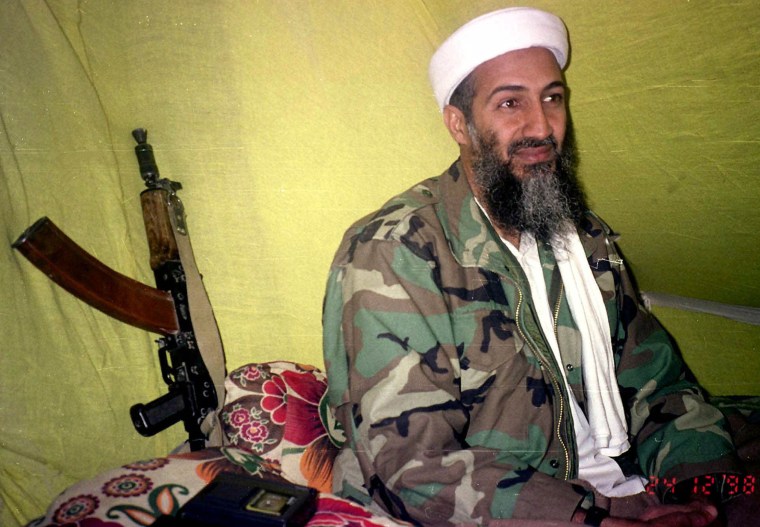WASHINGTON — Al Qaeda's leaders were increasingly worried about spies in their midst, drones in the air and secret tracking devices reporting their movements, documents seized in the 2011 raid on Osama bin Laden's Pakistani hideout reveal.
Translated and declassified by U.S. intelligence agencies, the cache of 113 documents are mostly dated between 2009 and 2011, according to intelligence officials.
The documents — the second tranche from the raid to have been declassified since May 2015 — depict an al Qaeda that was unwavering in its commitment to global jihad, but with its core leadership in Pakistan and Afghanistan under pressure on multiple fronts.
President Barack Obama has said drone strikes and other counter-terrorism operations depleted al Qaeda's original leadership, culminating in bin Laden's killing by U.S. Navy SEALs on May 2, 2011. In the years since, the organization has proved resilient from Afghanistan to North Africa, and ideological rival ISIS has grown and spread.
In one document, bin Laden issues instructions to al Qaeda members holding an Afghan hostage to be wary of possible tracking technology attached to the ransom payment.
Related: Al Qaeda Makes Comeback in ISIS' Shadow
"It is important to get rid of the suitcase in which the funds are delivered, due to the possibility of it having a tracking chip in it," bin Laden states in a letter to an aide identified only as "Shaykh Mahmud."
In an apparent reference to armed U.S. drones patrolling the skies, bin Laden says his negotiators should not leave their rented house in the Pakistani city of Peshawar "except on a cloudy overcast day."

While the document is undated, Afghan diplomat Abdul Khaliq Farahi was held hostage from September 2008 to late 2010.
In another, bin Laden expresses alarm over his wife's visit to a dentist while in Iran, worrying that a tracking chip could have been implanted with her dental filling.
"The size of the chip is about the length of a grain of wheat and the width of a fine piece of vermicelli," he wrote using the pseudonym Abu Abdallah.
The letter ended with this instruction: "Please destroy this letter after reading it."
In a May 11, 2010, letter to his then second-in-command, Atiyah Abd al Rahman, bin Laden urged caution in arranging an interview with Al Jazeera journalist Ahmad Zaidan, asserting that the United States could be tracking his movements through devices implanted in his equipment, or by satellite.
Related: Bin Laden Documents Detail His Daily Life
"You must keep in mind the possibility, however, slight, that journalists can be under surveillance that neither we nor they can perceive, either on the ground or via satellite," he wrote.
When asked whether bin Laden's constant paranoia was justified, a senior intelligence official responded, “He’s dead.”
Even as al Qaeda came under growing pressure, bin Laden and his aides planned a media campaign to mark the 10th anniversary of the Sept. 11, 2001, attacks on New York and Washington, the documents show.
They wanted to argue that they were winning, despite the losses and hardships outlined in the document. They discussed bin Laden himself doing an interview with Al Jazeera’s Islamabad bureau chief, and also using British journalist Robert Fiske, who they saw as an “honest broker,” according to a senior intelligence official. The documents do not, however, reveal attack plans for the anniversary.
Related: Here's What's on al Qaeda's Job Application
But they did plot diplomatic strategy and opined on climate change and the U.S. financial collapse.
In an undated letter "To the American people," the al Qaeda chief chides Obama for failing to end the war in Afghanistan; and accurately predicts that the U.S. president's plan for ending the Israeli-Palestinian conflict will fail.
The latest batch of documents also revealed:
- More details about how bin Laden intended to move from his Abbottabad, Pakistan, compound by fall 2011, suggesting the CIA and the SEALs got him just in time. The documents released so far don’t say where he wanted to move, or whether anyone in the Pakistani government of intelligence service was helping him.
- A clear picture that bin Laden was deeply involved in managing the organization, not hiding in a cave, as American officials used to like to say. He was in close touch with the affiliates, and intimately involved in policy debates. “You see through the documents that bin Laden was very hands on with the day to day running of the organization,” a senior intelligence official said. He gave clear instructions on media strategy and admonished affiliates not to show beheadings, for example, or photos of dead operatives, which he though were bad for morale. He urged the affiliates to attack the U.S., and if they couldn’t do that, attack France.
- How bin Laden urged his followers not to offend Iran, which he called “our main artery for funds, personnel and communications.” He was referring to jihadi networks, officials said, not Iranian government support. Bin Laden also complained about the rough conditions in which some al Qaeda people were being held in Iran.
Finally, the documents show how bin Laden still sought to exert influence on important world events until his ultimate demise.
On April 28, 2011 — just four days before his death in a firefight with U.S. forces in his Abbottabad compound — he was editing a document he had written on the Arab Spring revolutions.
Al Qaeda's leaders also urged further attacks on the United States. "We need to extend and develop our operations in America and not keep it limited to blowing up airplanes," says a letter, apparently written by bin Laden, to Nasir al-Wuhayshi, head of al Qaeda's Yemen branch.
Intelligence officials say there will be one more release of documents related to the raid on bin Laden's hideout, at which point a majority of the memos will have been made public.

